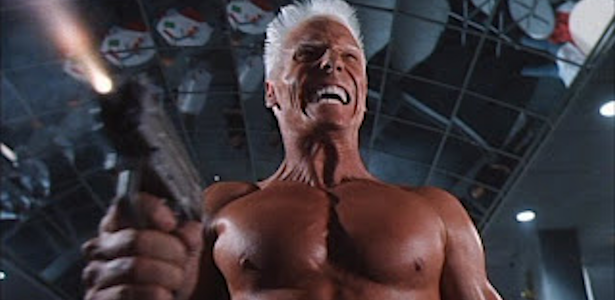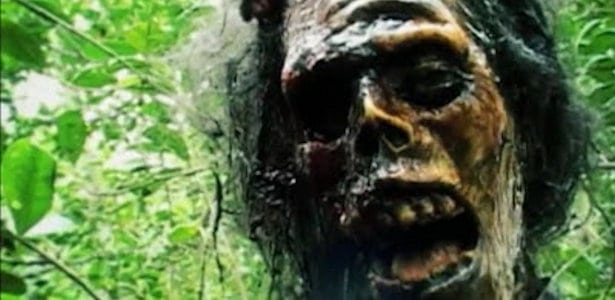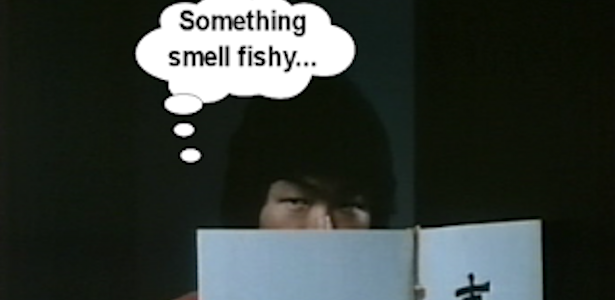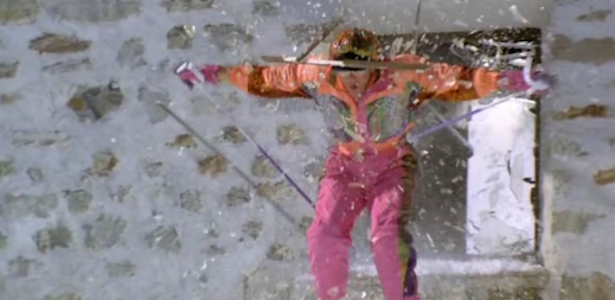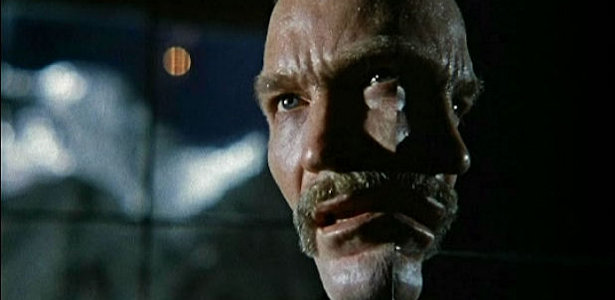In the 1980s censorship of mainstream exploitation cinema was so biased and heavy handed that genre films would frequently be completely bloodless affairs with jumpy edits and a loss of continuity where even the most mild of on-screen violence was removed. Just like any forbidden fruit, the more the public was denied, the more demand there was for the hard stuff. This caused a wide ripple of effects, one being the advent of the "unrated" video release, another being a booming grey market for bootlegs of foreign films (back in 1990 if you didn't have a crappy dupe of John Woo's THE KILLER, you were living under a rock). The most important effect came with the coincidental drop in price of the home video camera which allowed burgeoning "filmmakers" to be wild west outlaws and make incredibly gory movies that could not be censored due to the fact that, technically, censorship is unconstitutional under American law. If you didn't care whether your movie played theaters and you just wanted to release it directly to video, you could display any sort of gruesome mayhem that your twisted brain could think up, or your your refinanced mortgage could afford. Suddenly the floodgates opened and "gornography" was born. Movies like BLOOD CULT (1985), CANNIBAL CAMPOUT (1988), and 555 (1988) were making serious bucks in spite of having less talent and lower production values than a sixth-grade staging of "Saint George and the Dragon". Hell, 555 was so low-rent it didn't even have a distributor! It was marketed in the back pages of cult movie magazines luring in unsuspecting losers (like me) with its claims of "blood, gore, sex, nudity and other things we can't mention." After seeing it I realized that the things they couldn't mention were the complete lack of talent and production values.
 |
| One of the more introspective moments in the original VIOLENT SHIT |
In 2004, a day that will live in infamy, the highly political chairman of the MPAA, Jack Valenti, retired at the age of 82 years old. After decades of industry manipulation, favoritism and absurdly outdated views of controlling what the American people should have the right to see, genre movie fans found that change was in the wind. At first it seemed as if no-one really knew what to do or even if change had actually come. Then, in 2008, Stallone decided he would bring the most gore-soaked film to American screens that had ever been shown with an R-rating. RAMBO may not have been the theatrical blockbuster that the distributors were hoping for, but it was no less a milestone in American cinema and since then we have been able to witness on-screen carnage that would have been completely unthinkable previously. Even the British Board of Film Censors, who at one point were responsible for imprisoning videostore owners and film viewers for possessing a video box with the word "chainsaw" written on it, had taken a strong dose of reality and relaxed their psychotically stringent standards to allow classic films like THE BEYOND (1980) to be released in their uncut form.
After finding limited success with his attempts at making bigger movies that sacrificed crass for a modicum of class, Schnaas announced that he would retire from filmmaking. Apparently he was talked back into it by notorious SOV hack Timo Rose, whose imagination is only limited by his birth. For reasons unknown, Schnaas decided to split from long-time collaborateur (and wearer of very small shorts) Steve Aquilina, and teamed up with Rose for the virtually unwatchable UNRATED: THE MOVIE (2009).
 Using a few badly photoshopped images to represent a post-holocaust Earth, Karl once again finds himself in a familiar stretch of woods which has been divided up into gangs. Each gang has a theme of course, and every single gang member is given a name via on-screen titles, even if that character's only part in the film is to show up and have his name displayed. The gangs all hang out in their respective headquarters which consist of a 10x10 room draped with vinyl banners with the gang name printed on it, or in the case of the Amazonian gang, bed sheets. Led by Queen Scara (aging porn/softcore vet Eileen Daly who really shouldn't be taking her clothes off anymore), there only seem to be three other members of her gang, one of which is promptly killed off while guarding a path, completely naked, by Karl when she won't let him walk past her. I was starting to think this was an homage to MONTY PYTHON AND THE HOLY GRAIL, but Monty Python's bit was much bloodier.
Using a few badly photoshopped images to represent a post-holocaust Earth, Karl once again finds himself in a familiar stretch of woods which has been divided up into gangs. Each gang has a theme of course, and every single gang member is given a name via on-screen titles, even if that character's only part in the film is to show up and have his name displayed. The gangs all hang out in their respective headquarters which consist of a 10x10 room draped with vinyl banners with the gang name printed on it, or in the case of the Amazonian gang, bed sheets. Led by Queen Scara (aging porn/softcore vet Eileen Daly who really shouldn't be taking her clothes off anymore), there only seem to be three other members of her gang, one of which is promptly killed off while guarding a path, completely naked, by Karl when she won't let him walk past her. I was starting to think this was an homage to MONTY PYTHON AND THE HOLY GRAIL, but Monty Python's bit was much bloodier.Queen Scara, who only speaks in long, drawn out hisses (sounding much like the old Adolphus from the 1988 ADVENTURES OF BARON MUNCHAUSEN), is mainly obsessed with drinking male ejaculate ("only the female sperm is gooooood") obtained from rival gang members via a plastic "machine" that has "sperminator" scrawled on it in black sharpie. Assisting her in this is Mathra and Shema, played by Marysia Kay and Eleanor James, both ultra-low-rent trash regulars well known less for their acting skills and more for willing to work topless. Both of whom, incidentally, were in Ivan Zuccon's 2008 Lovecraft adaptation COLOUR FROM THE DARK, in which they (or at least Kay) provided substantially better performances.
 |
| That is one crazy gang alright. |
 After being introduced to all of the gangs (played mostly by small German bands) and Axe's sister, Vendetta (Timo's real-life girlfriend Magdalena Kalley), who is introduced with a flashy, whooshy freeze-frame title job, Axe and Vendetta kind of just hang out around the forest. Vendetta asks Axe about their parents, Axe says he doesn't know anything... Anyone still with me? C'mon, snap out of it. We're almost there. Eventually Karl and Axe meet in a woodland clearing and square off. So, now the scheisse is going to hit the lüfter, right? Hey, not so fast there buckaroo! Hold your horses, we still have more gang meetings to get through or this sucker isn't going to hit a feature-length running time! Occasionally we have a few gang members getting killed via impalement or yet another decapitation, but mostly, like you'd expect from a Timo Rose outing, it's just a lot of horrible performances from talking heads. Sure there are lots of attempts at humor (one gang member is called "Ninja Foo"), and there's a bit of unintentional humor such as when Karl's path is yet again obstructed:
After being introduced to all of the gangs (played mostly by small German bands) and Axe's sister, Vendetta (Timo's real-life girlfriend Magdalena Kalley), who is introduced with a flashy, whooshy freeze-frame title job, Axe and Vendetta kind of just hang out around the forest. Vendetta asks Axe about their parents, Axe says he doesn't know anything... Anyone still with me? C'mon, snap out of it. We're almost there. Eventually Karl and Axe meet in a woodland clearing and square off. So, now the scheisse is going to hit the lüfter, right? Hey, not so fast there buckaroo! Hold your horses, we still have more gang meetings to get through or this sucker isn't going to hit a feature-length running time! Occasionally we have a few gang members getting killed via impalement or yet another decapitation, but mostly, like you'd expect from a Timo Rose outing, it's just a lot of horrible performances from talking heads. Sure there are lots of attempts at humor (one gang member is called "Ninja Foo"), and there's a bit of unintentional humor such as when Karl's path is yet again obstructed:Karl: "Go out of my way!"
Gang Member: "You're Karl the Butcher, right? I thought you were in Hell."
Wait. How does some random dude who hangs out in the post-apocalypse woodland area know who exactly is in hell?
 Finally everything boils down to a donnybrook in a quarry lined with shipping containers and Karl taking a potion that causes him to look like he is in one of those inflatable sumo wrestler outfits. This is easily the best part of the movie, since it is Karl and Axe (who have teamed up after discovering they both have the same birthmarks) killing off all of the remaining gangs, except the chicks who have decided the best plan of action is to wait it out. Once again Timo Rose's complete and total lack of imagination is raised into sharp relief as the only way Karl and Axe can be bothered to kill anyone is with a slash, a stab or a decapitation. Matter of fact there are so many close-ups of decapitated stumps that the whole thing starts feeling like a bad GWAR video. Not to completely flog the point, but what is the reason you'd even be bothered to watch a VIOLENT SHIT movie in the first place? Yes, it's the whole smorgasbord of crazy gore effects. Part III actually offered up some surprisingly professional and creative demises, including smashed heads, ripped out spines, and disembowelments galore. It's like TITUS ANDRONICUS without all the deep thought. Instead we simply get a lot of very sloppy filmmaking, even by German SOV standards.
Finally everything boils down to a donnybrook in a quarry lined with shipping containers and Karl taking a potion that causes him to look like he is in one of those inflatable sumo wrestler outfits. This is easily the best part of the movie, since it is Karl and Axe (who have teamed up after discovering they both have the same birthmarks) killing off all of the remaining gangs, except the chicks who have decided the best plan of action is to wait it out. Once again Timo Rose's complete and total lack of imagination is raised into sharp relief as the only way Karl and Axe can be bothered to kill anyone is with a slash, a stab or a decapitation. Matter of fact there are so many close-ups of decapitated stumps that the whole thing starts feeling like a bad GWAR video. Not to completely flog the point, but what is the reason you'd even be bothered to watch a VIOLENT SHIT movie in the first place? Yes, it's the whole smorgasbord of crazy gore effects. Part III actually offered up some surprisingly professional and creative demises, including smashed heads, ripped out spines, and disembowelments galore. It's like TITUS ANDRONICUS without all the deep thought. Instead we simply get a lot of very sloppy filmmaking, even by German SOV standards.Scenes simply feel episodic and jumbled together, easily interchangable, as if they were shot over series of weekends without a script... actually, that's probably true, but some of it is so pointless that you can't help but wonder why even bother in the first place. For example, a character is introduced as "Sgt Riedel the Last German Soldier on Earth" early on in the movie. He has a few scenes where he's walking around spliced into the movie, but has nothing to do with anything! No interaction with other characters, just this dude, running across a field, or crossing a road. Right at the end, as sort of a non-sequitur epilogue, a badly CG'd stealth bomber flies low and the camera gets gobbed with a blob of CG blood (implying that the Sgt was hit by the plane). I can only think that this footage was shot, forgotten about, discovered and then thrown in simply as a way to pad out the running time. Essentially this is a 30 minute movie padded out to about 75 very long minutes.




